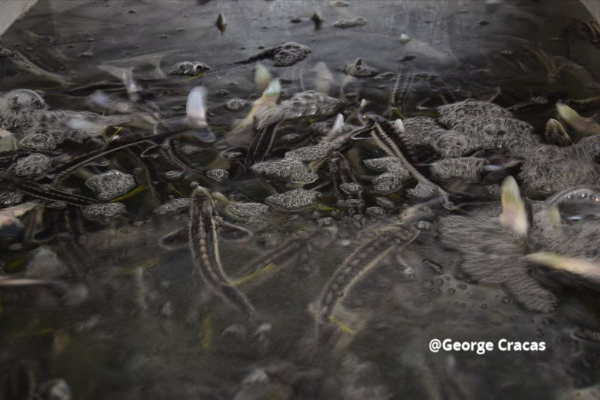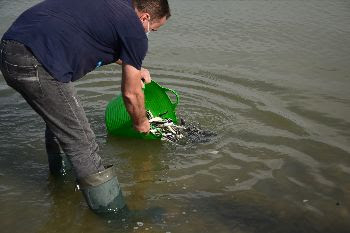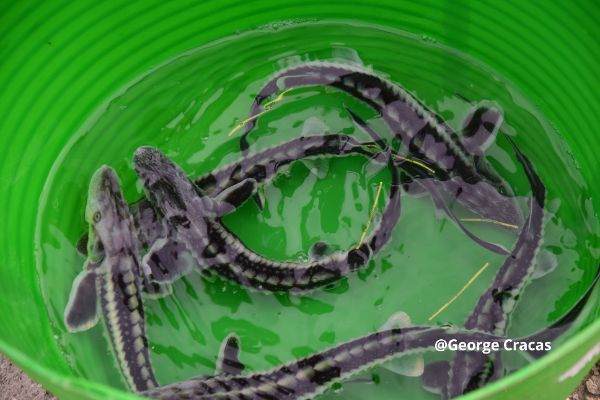700 Russian Sturgeons Successfully Released Into The Danube River

Seven hundred Russian sturgeons were released into the Danube on October 16, one week before the World Fish Migration Day (October 24). This is the second restocking event organised in Isaccea in 2020 by the “Danube Delta” National Institute for Research and Development (DDNI), WWF-Romania’s partner in the MEASURES[1] project.
The Russian sturgeon (Acipenser gueldenstaedtii), a native sturgeon species from the Danube, can reach 2.35 m in length and weigh over 100 kg. But the sturgeons released now barely exceed 25 cm and 150g the normal size for 6 month-old sturgeons. They will most likely not stay in the Danube, but will migrate to the sea in a few days, where the water temperature fluctuations are not so great and where there is more food for them than in the river. All sturgeons were tagged so that they can be identified in the event of an accidental capture or during scientific research.

"Each sturgeon has an external tag with the name of the project and the telephone number where the accidental capture of a sturgeon can be reported. But fishermen in the area already know about our restocking actions and usually release them in case they accidentally catch them. Especially since some of the fishermen also know that the Russian sturgeon is the most vulnerable sturgeon species." - Marian Paraschiv, DDNI Tulcea.
Also known as the diamond sturgeon or Danube sturgeon, the Russian sturgeon is increasingly rare in Danube waters, appearing on the IUCN Red List of critically endangered species. Like most migratory fish, population decline of this species is caused by human-based activities such as the growth of the hydropower sector, overfishing, climate change and pollution. As a result, not only sturgeons, but most populations of migratory freshwater fish species have declined on average, by 93% in Europe since 1970.[2]

"Rivers that flow freely and migratory fish, such as sturgeon, trout and Danube shad are extremely important for local communities – being in the past a source of food - but also for those who live beyond the river. These fish play an essential role in the health of rivers, lakes and wetlands by maintaining a complex food chain. That is why in the MEASURES project, we chose to mark the World Fish Migration Day through a restocking activity, among others,” added Cristina Munteanu, Project Manager, WWF-Romania.
Another 300 one year-old Russian sturgeons were released at Isaccea in April, and 1000 last year. This is the third restocking action organised within the MEASURES project in Romania, and brings the total number of sturgeons released in the Danube in Romania and Hungary to almost 9000. The release activity took place in the presence of representatives of the DDBRA (Danube Delta Biosphere Reserve) and NAFA (National Agency for Fisheries and Aquaculture) as administrators of aquatic resources, and of the representatives of DDNI as organisers of the action. The MEASURES project is co-financed by the European Union (ERDF, IAP). For more details, please visit the project website.
[1] Managing and Restoring Aquatic Ecological Corridors for Migratory Fish Species in the Danube River Basin
[2] The Living Planet Index (LPI) for Migratory Freshwater Fish
About the
project
MEASURES
(01.06.2018-31.05.2021) includes 10 countries along
the Danube (Germany, Austria, Slovakia, Slovenia, Hungary,
Croatia, Serbia, Romania and Bulgaria). The project partners
have joined forces to conserve endangered migratory fish
species in the Danube River Basin (DRB). During the three-
year project, MEASURES will map and identify key habitats by
developing and testing a methodology for migratory fish
habitat mapping, develop a harmonised strategy for restoring
ecological corridors, and support inclusion in future
management plans. The project will also compile an online
database - the “MEASURES Information System” – that
will facilitate the access of experts, decision-makers and
the general public to the relevant information
available.


 ICHRP: ICHRP Condemns Harassment And Threats Against Victims Of Duterte’s War On The Poor
ICHRP: ICHRP Condemns Harassment And Threats Against Victims Of Duterte’s War On The Poor World Vision: 3.5 Million Displaced Following Myanmar Earthquake And Ongoing Internal Conflict
World Vision: 3.5 Million Displaced Following Myanmar Earthquake And Ongoing Internal Conflict World Butchers Challenge: World’s Top Butchers From 14 Nations Go Knife-to-Knife In Paris
World Butchers Challenge: World’s Top Butchers From 14 Nations Go Knife-to-Knife In Paris Save The Children: ‘It Was Terrifying’ - Children Prepare To Spend Myanmar New Year Festival In Shelters Following Earthquake
Save The Children: ‘It Was Terrifying’ - Children Prepare To Spend Myanmar New Year Festival In Shelters Following Earthquake Global Forest Coalition: Global NGOs Call On International Maritime Org To Reject Biofuels And Commit To Truly Clean Energy
Global Forest Coalition: Global NGOs Call On International Maritime Org To Reject Biofuels And Commit To Truly Clean Energy Australian Catholic University: Principals Navigate Growing Challenges As Anxiety, Depression Increase And Violence, Workloads Intensify
Australian Catholic University: Principals Navigate Growing Challenges As Anxiety, Depression Increase And Violence, Workloads Intensify